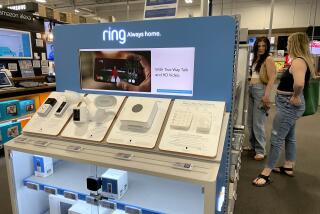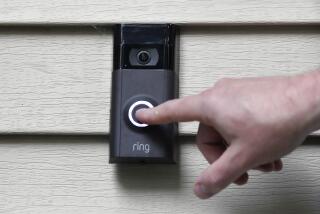COLUMN ONE : Enough With the Gadgets : Americans passed on the video telephone. It seems wary consumers want utility and not just bells and whistles.
- Share via
George Jetson has one; it’s been standard equipment on his cartoon planet for nearly 30 years. But can you get a picture telephone in your house today? No way.
Three years ago, though, you could. Then, Sony, Mitsubishi and Panasonic were all selling pioneering video phone models that quickly captured the imagination of futurists, trend-seeking market analysts and headline writers. Unfortunately for the manufacturers, only a relatively few gadget-happy shoppers followed suit.
Shortly after the hype and hoopla subsided, the products were quietly pulled off the market. Sony, confides one insider, doesn’t like to admit the product even existed. Mitsubishi peddled the last of its models, priced originally at $3,300 a pair, over the Home Shopping Network for a mere $500 a pair.
“It was a sexy product that people everywhere stopped to look at. But they just didn’t buy it,” shrugs Ric Fochtman, executive vice president for Mitsubishi Electronics America Inc. in Cypress. “It just wasn’t the product they wanted.”
It’s been that way in the home automation and appliance business for a while. Despite the promises and advanced visions--many of them aimed at replicating the animated home of Jane and George Jetson--progress had been riddled with misguided efforts, laggard development and, most importantly, unexpectedly slow and wary consumer acceptance.
The upshot? With few exceptions--notably the microwave oven and a handful of minimally computerized appliances--the state of home automation today is not much more advanced than it was a decade ago.
And the outlook isn’t much more encouraging. Although there are promising developments on the horizon, home builders, appliance manufacturers and utility service suppliers so far have been stymied in their efforts to bring the latest computer-style electronics and communications to the everyday operation of the average American home.
Their ultimate goal is not a house like the Jetsons’, packed with such far-out gizmos as a meal-dispensing “food-a-rack-a-cycle” and a seeing-eye vacuum cleaner. Instead, they’re after a home with a far more mundane ability: taking care of itself and sparing its owner needless operational and repair expense.
In this vision, self-diagnosing appliances and utility systems would not only recognize any operating problems, but report them, via ordinary telephone lines, to maintenance and repair crews. Landscaping irrigation systems would come with built-in weather sensors to improve water conservation. Indoor heating and air conditioning could be controlled and monitored to reduce waste and minimize costs. And appliances could be programmed to operate during hours of off-peak utility rates.
These concepts are more than the dreams of overly imaginative engineers.
Currently, prototypes of such homes--called “Smart Houses”--are being built nationwide under the auspices of the National Assn. of Homebuilders, including one by Southern California Edison in Covina. However, these initial efforts, scheduled for unveiling in April, 1991, are aimed only at new home construction, a slim sliver of the entire housing market. Products for the nation’s huge market of perhaps 80 million existing homes are not expected for years, delayed while the home remodeling and appliance industries select the best and easiest way to accomplish the retrofit.
Until then, analysts say, home automation will limp along as it has, offering fancy security systems, programmable thermostats and a smattering of computer-driven utility and security management devices. Sales of these devices--which range in cost from several hundred dollars for the simplest to tens of thousands of dollars for the most upscale--should exceed $900 million this year, and $2.2 billion by 1995, a far cry from their full potential, says Trisha Parks, a home automation market researcher in Dallas.
There is ample historical precedent for the slow acceptance of new technology into the American home.
Consider the dishwasher. Although introduced in 1886, sales some 45 years later were limping along at the rate of about 7,500 a year. Even the microwave oven, perhaps today’s top-selling appliance, took years to find its place in the kitchen after its accidental discovery in 1946. (According to the lore, the cooking power of microwave energy was discovered by a researcher who noticed that a chocolate bar in his shirt pocket melted while he was experimenting with high-frequency radar waves.)
Some say the lack of technology isn’t the problem.
“Right now the technology is generally available to give us the house that we all want, the house that can take care of itself and diagnose its problems,” Parks said. “The primary barrier is cost. Consumers aren’t willing to spend money on technology, just for the sake of it. They want to know that whatever technology they are buying will save them either time or money. Cost is the major issue.”
Consumers also may be intimidated by sophisticated gadgetry.
“Consumers aren’t against technology, but they won’t buy it if it’s too complicated. That’s why people still use their microwaves only to defrost and the videocassette recorders only to play prerecorded tapes,” says Thomas Riley, president of Unity Systems, manufacturer of a computerized utility and security control system for the home. “The devices can do far more, but the consumer doesn’t attempt it because it’s too much bother.”
Others blame the slow acceptance on the lack of a uniform development standard. Without widely accepted manufacturing and communication protocols for the electrical appliances, security systems and other household items, linking them to each other and to telephone systems is a daunting task. So rather than plunge into uncharted territory, many manufacturers have generally stayed on the sidelines, waiting for the completion of the Smart Houses project, which will produce a set of standards for linking appliances.
But could another factor be male chauvinism? Ruth Schwartz Cowan, who teaches the history of technology at State University of New York in Stoney Brook, doesn’t rule it out.
“The kinds of things women would like in their homes are not the kind of things male engineers are interested in developing,” she argues. “Just look at robots. Engineers love them, but most things a robot can do wouldn’t be critical time savers in the home. In fact, the most time-consuming tasks in the home--food preparation and clean-up--can’t be done by a robot.”
Whatever the reason, the marketing team at Mitsubishi had no idea that its Lumaphone, unveiled in 1987, would meet its ignominious fate on the Home Shopping Network just two years later.
Initial reviews of the video phone were smashing. It was the star attraction of a couple of trade shows. And consumers seemed intrigued by the technology.
Then reality set in. Consumers were disappointed in what the system actually offered. It projected only static black-and-white photos, about 3 inches square. Only one picture at a time could be transmitted across a telephone line, and during the two or three minutes it took to send the picture, no conversation was allowed.
Finally, there was the sticker shock. The units were priced at $1,599 each, and consumers quickly learned that the system was useless unless purchased in pairs because the person on the other line needed one too. “At those prices people said they would rather wait until the phone offered full motion video and color,” recalls Fochtman.
“George Jetson’s phone, that really is the future. And we learned that consumers have that same vision too,” he adds. “Only they’re not willing to buy the intermediate product.”
The Lumaphone wasn’t Mitsubishi’s only failure during 1987. At the same time the phone was introduced, a team of advanced engineers rolled out the company’s deluxe home management system, a computer-like device that could control the lights, temperature, security alarms, intercom and piped-in music in every room of the house. The only problem with the system, recalls one company insider, is that it practically required a Ph.D. in engineering to operate.
The system, which never made it into production, was sent back to the research labs in Japan for further work, and has not been heard of since. Company officials decline to reveal how much the company spent developing the prototype.
Mitsubishi is far from alone at misjudging the consumer’s appetite for household wizardry. In the early 1980s, Sharp Electronics introduced a microwave oven in the United States that came equipped with 30 electronically encoded recipe cards. The idea was to pop the food into the oven, run the recipe card through the “reader” as you would run a debit card through a bank automated teller machine, and walk away. Dinner was ready when the beeper sounded.
The machine, which cost about $100 more than comparable models, was pulled off the market when customers balked at the price tag. Sharp officials say the lesson they learned from the recipe card fiasco has kept them from introducing a couple of kitchen items that have proven popular in Japan, including a $1,000 microwave oven that comes with its own bar-code scanning wand and bar-code labeled cookbook, whose purpose is similar to that of the original model with the recipe cards.
“Compared with their Japanese counterparts, U.S. consumers are not all that gadget-happy,” says Ann Howard, Sharp’s national marketing manager in Mahwah, N.J. “The U.S. consumer is more interested in products with good value, not necessarily all the latest bells and whistles.”
More to Read
Inside the business of entertainment
The Wide Shot brings you news, analysis and insights on everything from streaming wars to production — and what it all means for the future.
You may occasionally receive promotional content from the Los Angeles Times.










